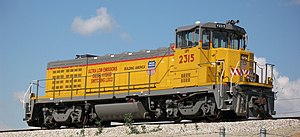

| Railpower GG20B | |||||||||||||||||||||||
|---|---|---|---|---|---|---|---|---|---|---|---|---|---|---|---|---|---|---|---|---|---|---|---|

A Railpower GG20B hybrid genset in the Union Pacific paint scheme
| |||||||||||||||||||||||
| |||||||||||||||||||||||
| |||||||||||||||||||||||
| |||||||||||||||||||||||
The Railpower GG20B Green Goat is a low-emissions diesel hybrid switcher locomotive built by Railpower Technologies Corp. It is powered by a single Caterpillar C9 six cylinder inline engine developing 300 horsepower (224 kW), which is also connected to a large battery bank where both sources combine for a total power output of 2,000 horsepower (1,490 kW). To date, there have been more than 50 GG20B diesel-electric hybrid switchers manufactured since their first introduction in 2004.[2]
| Railroad | Quantity | Road number(s) | Notes |
|---|---|---|---|
| Bechtel Group | 1 | 2000 | Now S&S Sales and Leasing SSRX 2000[3] |
| BNSF Railway | 4 | 1210-1213 | 1205 Ex-Canadian Pacific Railway |
| Canadian Pacific Railway | 6 | 1700-1705 | Railpower contract later terminated, units sent to different owners. Amtrak 599 BNSF Railway 1205 |
| Kansas City Southern Railway | 2 | 1868-1869 | |
| Lubrizol Corporation | 1 | 2006 | |
| Modoc Railroad Academy | 1 | 2608 | Now S&S Sales and Leasing SSRX 2608[4] |
| Railpower Technologies | 5 | 2401-2405 | Demonstration Units |
| Railserve | 10 | 414, 1602, 1621, 1810, 2402, 2605, 4495, 4547, 8049, & 9140 | Ordered with non-consistent running numbers |
| Union Pacific Railroad | 21 | Y2004 & Y2300-2319 | Units classed by UP as "GG20GE" |
| United States Army | 4 | 6000-6003 | |
| Total | 55[5] |
BNSF Railway and Vehicle Projects converted a GG20B to an experimental testbed, for the use of hydrogen fuel cells. The new locomotive is designated HH20B. The locomotive was publicly demonstrated for the first time on June 29, 2009, at Topeka, Kansas.[6][7]
The locomotive, BNSF 1205, was originally built in 1957 as Canadian Pacific 8637 (renumbered 1544 in the 1980s), a GMD GP9 locomotive.[8] In 2006, it was rebuilt into a GG20B for the Canadian Pacific, but was not delivered, due to the cancellation of the order. It was sold to BNSF in 2008, and shipped to the railroad's shops at Topeka, Kansas for conversion. The diesel generator set was removed, and the fuel cell power unit was installed in its place. Hydrogen storage is in a set of tanks installed in a heavily vented enclosure on top of the locomotive's long hood, above the batteries.[9] To date, it is the largest land vehicle on earth to be powered exclusively by hydrogen fuel cells.[10]
In 2023, the locomotive (without its hydrogen components) was donated to the Oklahoma Railroad Museum, which plans on using it as a control car and for electricity generation on the end of its excursion trains.[11][8]
| External images | |
|---|---|
|
Low emissions locomotives in North America
| |||
|---|---|---|---|
| Altoona Works |
| ||
| Brookville Equipment |
| ||
| GE Transportation |
| ||
| Knoxville Locomotive Works |
| ||
| MotivePower |
| ||
| National Railway Equipment |
| ||
| Progress Rail |
| ||
| Railpower Technologies |
| ||
| Siemens Mobility |
| ||
See also: List of low-emissions locomotives in North America | |||
|
| |||||||||||||||
|---|---|---|---|---|---|---|---|---|---|---|---|---|---|---|---|
| Current |
| ||||||||||||||
| Former |
| ||||||||||||||
See also: Amtrak paint schemes | |||||||||||||||
This diesel locomotive-related article is a stub. You can help Wikipedia by expanding it. |